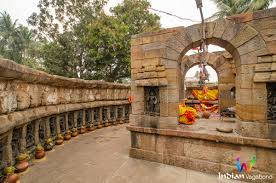Odisha: Hirapur, a Citadel of 64 Yoginis Reflecting Shakti Cult

Chausath Yogini Temple in Hirapur, Odisha
In India, there were many Yogini temples but as on date only four are surviving, one of which is located about 20 km from Odisha’s state capital, Bhubaneswar, in a place called Hirapur.
The ‘tantric’ cult has been there for centuries in the country reflecting its (shakti) nuances in certain forms at different times.
For many years, this cult was believed to have been lost but some people who had studied it deeply hold the view that the ‘tantric; cult was not lost but remained neglected and has now re-emerged due to its sheer “power”.
The cult’s spiritual essence and the quest for peace were few of its cardinal goals.
While driving on the national highway toward Puri from Bhubanewar, on the left one can see Hirapur, a non-descript village that later came to be known for the Chausath (64) Yogini temple.
As one enters the temple, the solemnity of the interiors is overwhelming. The timeless and meticulous sculptures remind one of a period when the cult took refuge in its own composure, which vividly manifested in these sculptures.
Sculpted on stones, each figurine stands like a living sentinel of a past when the quest for peace was the goal of the “tantric cult”.
Of the remaining three temples, one is located in the Bolangir district while the other two are in Madhya Pradesh. The shrine is locally known as Chausathi Yogini, meaning 64 Yoginis (by implication, incarnations of Goddess Durga).

At the Hirapur shrine, the presiding deity is Mahamaya, one of the principal Yoginis that stands right at the centre of the open-air circular temple. The rest of the sculptures are fixed on the walls. The tranquility in the temple creates a sense of mystique.
The daily prayer and rituals in the temple include the worship of Bhumandala, that is the five elements of nature -- water, sky, fire, earth and air.
The Yogini practice has been known to include Yoga along with the practice of “tantric” cult, having a strong connection with tribal and rural traditions also.
However, many sculptures suffered damages over a period, after which the shrine was handed over to the Archaeological Survey of India (ASI) in the late 1950s. As was evident, a lot of hard work seems to have gone in its restoration.
“There was a time when the shrine was physically oblivious. Subsequently, in 1953, a famous historian of that time, Kedarnath Mohapatra, discovered it and played a key role in restoring it to its present shape,” recalls Banshidhar Dwivedi, the septuagenarian priest in the shrine.
The good news was that after that the shrine underwent massive repair, internally and externally.
This temple is believed to have been built by Queen Hiradevi of the Bhaumakar dynasty in 9th Century AD.
Asked about ‘tantra vidya’ i.e. knowledge, historian Debraj Pradhan said: “Yes, it exists, both in written manuscripts as well as in practice that say the patronage of the then rulers helped the cult to flourish.”
Hence, its charge is given to a disciple only when he or she fulfils certain conditions and practices the cult with devotion. And, above all, keeps its pure tradition intact.
The names of a few Yoginis are:
Yogini 1 – Maya / Bahurupa / Chandika.
Yogini 2 – Tara.
Yogini 3 – Narmada.
Yogini 4 – Yamuna.
Yogini 5 – Shanti / Kanti / Laxmi / Manada.
Yogini 6 – Vriddhi / Kriya / Varuni.
Yogini 7 – Ajita / Gauri / Ksemankari.
Yogini 8 – Indrani / Aindri.
Interestingly, the Yogini idols in the gallery represent female figures standing on an animal, a demon or a human head (known as vahanas) depicting the victory of Shakti (Eternal Power).
“According to Hindu mythology, ‘aadishakti’ is the eternal power which came into existence on its own and then created everything by its will. It (recognised as the goddess because of its maternal character) is the supreme power” said Pradhan.
The idols express everything, from rage, sadness, pleasure, joy, desire and happiness.
According to legends, as heard from the old priests at Hirapur, the creation of the Yoginis was an effort by the Aadi-Shakti Goddess Durga, who herself accepted the form of 64 Yoginis to defeat a demon and subsequently, they were all commemorated inside such temples in several parts of India.
The writer is a freelance journalist based in Odisha.
Get the latest reports & analysis with people's perspective on Protests, movements & deep analytical videos, discussions of the current affairs in your Telegram app. Subscribe to NewsClick's Telegram channel & get Real-Time updates on stories, as they get published on our website.
























